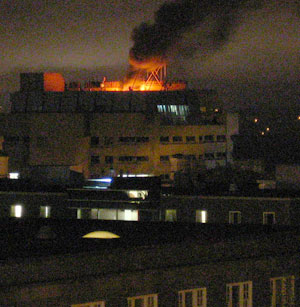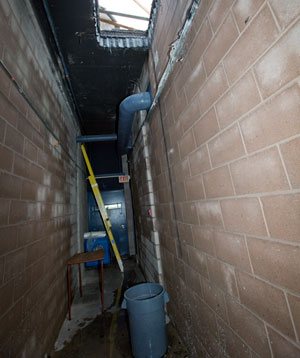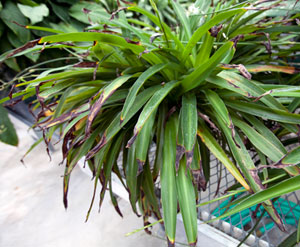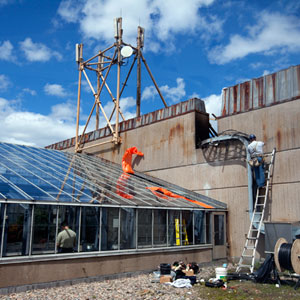 |
| This picture of the LSC fire was used by the CBC and The Chronicle Herald in their reports. It was taken by Dal alum Stephanie Pelley at around 11 p.m. on July 24 from a seventh floor balcony in LeMarchant Towers, on the corner of LeMarchant and Coburg Streets. She also reported hearing a "really loud bang." (Photo courtesy of Stephanie Pelley) |
When Carman Mills saw the dramatic photograph of the fire on the roof of the Life Sciences Centre (LSC), he wondered if the plants in the rooftop greenhouse weren’t anything more than cinders.
In that scenario, the sight of 10 broken panes of glass and two inches of water on the floor of his office and two laboratories came as a relief.
“Relief is a good word,” says Mr. Mills, greenhouse manager for the Department of Biology. “Now it’s a matter of cleaning up.”
Because the greenhouse filled with smoke, it will be some time before it can be determined if plants were damaged, adds Mr. Mills.
The fire happened the evening of Saturday, July 24. AVæ„¿÷≤ø‚Äôs Security Services were alerted to the fire by HRM 911 at 10:48 p.m. Dal Security and Halifax firefighters arrived on scene within minutes.
No one was injured and the fire was quickly contained. In a summary posted to its , Halifax Regional Fire & Emergency Service's Fire Prevention Service deemed the fire to be "accidental."
"The ignition source was a propane torch used earlier in the afternoon,‚Äù says Dave Meldrum, divisional chief of safety for the fire department. ‚ÄúThe torch was¬Ýused to soften the rubber membrane around the access hatch and stick it in place.‚Äù
| ||
| ||
|
The roofers had wrapped three weeks of work on Saturday afternoon, said Philip Li, mechanical project leader for AVæ„¿÷≤ø‚Äôs Facilities Management.
Now all that remains of the hatch are small shards of aluminum blasted on to the concrete wall of an eighth-floor corridor. The walls and ceiling of the corridor are blackened and smells of smoke. As well, two adjacent laboratory spaces for the greenhouse were covered in soot, although water from the floors had been vacuumed.
“We are very fortunate that it was a localized event,” assessed Chris Moore, Dean of Science, whose office is on the eighth floor and was unaffected by the fire. “The greenhouse and greenhouse storage took the brunt of it. All the academic and administrative workspace was not touched at all.”
There was also water damage to the Chase Building. When firefighters hooked up their equipment, a boost in water pressure led to a water line break in the basement.
‚ÄúWe‚Äôre actively repairing that at this time,‚Äù says Darrell Boutilier, director of operations for AVæ„¿÷≤ø‚Äôs Facilities Management. To do that work, sprinkler systems have been shut down in adjacent buildings, including the Chemistry building and Chemical Storage Facility.
Repairs to water pipes and the sprinkler lines continued through Monday evening, July 26. After testing and inspecting systems, Facilities Management was able to re-open the Chemistry Building and the Chemical Storage Facility¬Ýby noon on¬ÝTuesday, July 27.
Ray Ilson, director of AVæ„¿÷≤ø's Environmental Health and Safety Office, is requesting a more detailed report from the fire investigator. He adds that AVæ„¿÷≤ø‚Äôs internal investigation into the blaze is ongoing.
Math books soakedThe math library in the Chase building was seriously affected by the flood, with "water rising up to four or more inches above the bottom shelves where many journals were housed," says William Maes, AVæ„¿÷≤ø Librarian. Approximately 1,200 volumes of bound mathematics journals were affected. ‚ÄúWe are in the process of determining which are unique to us, unique in the country or available in electronic form,‚Äù says Mr. Maes. Water-damaged Books need to be dealt with usually within 24 hours or mold will set in and infect the rest of the collection. The water-damaged journals were sent to Atlas Refrigeration for freezing. Freezing is a way of stabilizing wet books until they decide which book, if any, are worth salvaging. Given the suddenness of the (fire and burst pipes), this quick action bought the library time to decide what to do with this damaged collection. "Since restoring water soaked books is a labour intensive process," Mr. Maes says, "and there are so many we will need to make decisions regarding what must absolutely be saved or what can be obtained from elsewhere or done completely without." Over the next few weeks, Karl Dilcher, chair of the Department of Mathematics and Statistics, and library staff will determine what can be salvaged and what must be discarded. ‚Äî Andy Murdoch |



